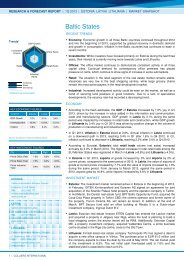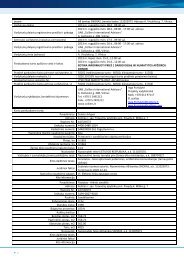baltic states and belarus real estate market review - Colliers
baltic states and belarus real estate market review - Colliers
baltic states and belarus real estate market review - Colliers
Create successful ePaper yourself
Turn your PDF publications into a flip-book with our unique Google optimized e-Paper software.
Real Estate Market Review 2011 | Estonia Office Market<br />
Dynamics of Rent Rates in<br />
Tallinn<br />
Rental Rates (EUR)<br />
26<br />
22<br />
18<br />
14<br />
10<br />
6<br />
0<br />
2005<br />
2006<br />
2007<br />
2008<br />
2009<br />
Class A Class B1 Class B2<br />
Rent Rates<br />
The main changes in office rental <strong>and</strong><br />
vacancy rates took place in the first half of<br />
2009 when many companies started to<br />
restructure their activities <strong>and</strong> look<br />
aggressively for cost saving opportunities.<br />
Office rent rates started to decline<br />
dramatically only in Q4 2008, significantly<br />
dropped during the first six months of 2009<br />
when A <strong>and</strong> B properties showed an average<br />
year-on-year drop of 25 - 40 per cent in<br />
rental rates, while rent rates for new<br />
premises outside CBD decreased up to 50<br />
per cent. In the second half of 2009 office<br />
rental rates started to stabilize.<br />
In early 2010, rent rates remained more or<br />
less on the same level since 2009, although<br />
the range of asking rent rates (especially for<br />
B1 Class buildings) became wider. In order to<br />
attract new tenants l<strong>and</strong>lords have agreed to<br />
rent out office space to tenants during first<br />
one or two years of lease agreement for a<br />
rent that is significantly lower than the <strong>market</strong><br />
average price.<br />
Overall in 2010 the average asking rental<br />
rates decreased by 2 - 5 per cent due to a<br />
small decrease in average rental prices for A<br />
Class properties <strong>and</strong> decrease in the lower<br />
end prices for B1 Class properties. At the<br />
same time, while the average asking rental<br />
rate continued its falling trend, the rental<br />
rates in contemporary office buildings in<br />
good location have stabilized or even<br />
somewhat increased.<br />
The Tallinn office <strong>market</strong> remains a tenant’s<br />
<strong>market</strong>, with a good range of choice <strong>and</strong><br />
attractive rental rates. However, lease<br />
incentives, rent-free periods <strong>and</strong> partial fitout<br />
compensation are less likely to be offered<br />
to tenants now compared with the crisis<br />
period.<br />
Office rental rates are expected to remain<br />
more or less stable during 2011. A sharp<br />
increase in construction prices in 2010 have<br />
put pressure on the average rental rates of<br />
potential developments, although tenants are<br />
not yet prepared to pay higher rents.<br />
Rental rates in Tallinn are typically 15-17 per<br />
cent lower than average rent rates in main<br />
Eastern European capitals.<br />
Vacancy<br />
A strong supply of new office projects<br />
accompanied by the economic slowdown <strong>and</strong><br />
tenants’ cost-saving policies (reducing the<br />
size of office space requested, renegotiating<br />
rents, <strong>and</strong> sub-leasing excess office space)<br />
resulted in an increase in vacancy rates in<br />
2009.<br />
There were no new contemporary office<br />
buildings accruing to the <strong>market</strong> in 2010, <strong>and</strong><br />
the vacancy rate of existing office buildings<br />
(especially for A-class properties) started to<br />
decrease gradually. The key strategy for<br />
attracting new tenants became active<br />
<strong>market</strong>ing <strong>and</strong> communication, not only the<br />
cheapest rental rate.<br />
By the end of 2010, the situation in the office<br />
sector had improved for l<strong>and</strong>lords who are<br />
flexible with pricing, thus the vacancy rate in<br />
A <strong>and</strong> B1 office buildings is slightly<br />
decreasing. The average vacancy rate for<br />
Class A offices varied in the range of<br />
12 - 15 per cent at the end of 2010 while the<br />
average vacancy rate for Class B offices<br />
varied in the range of 14 - 17 per cent.<br />
Dynamics of the Vacancy Rate in Tallinn<br />
35%<br />
30%<br />
25%<br />
20%<br />
15%<br />
10%<br />
5%<br />
0%<br />
Jan 2005<br />
JUne 2005<br />
Jan 2006<br />
June 2006<br />
Jan 2007<br />
2010<br />
June 2007<br />
Jan 2008<br />
June 2008<br />
Jan 2009<br />
June 2009<br />
Jan 2010<br />
June 2010<br />
Jan 2011<br />
Class A Class B1 Total<br />
CONTACT: AVO RÕÕMUSSAAR - a.roomussaar@colliers.ee<br />
<strong>Colliers</strong> International | p. 56













